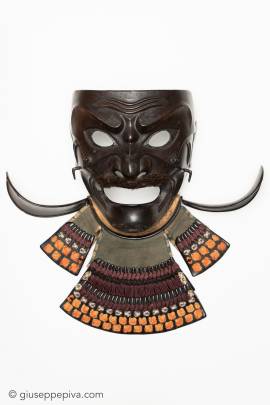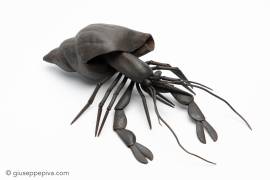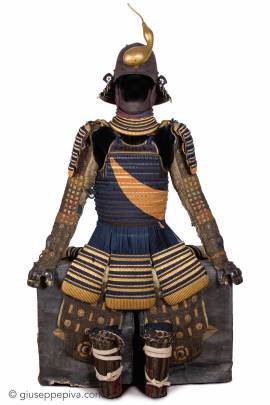A full-face russet iron samurai amour’s mask with fierce expressionEarly Edo period, 17th -18th centuryProvenance:Kyoto, Arashiyama MuseumLiterature:Kyoto Arashiyama Bijutsukan, catalog, pag. 28Iida Kazuo, Katchû-men (Tokyo, 1991), cat. 123Rare lacquered iron sōmen lacquered in kuro-urushi. The mask, with an expression both strong and elegant, is constructed in two parts only, with the nose incorporated into the upper section. This type of fabrication is found in some sōmen signed by Wushu Masanobu, of which other features, such as the shape of the side wrinkles and the protuberance...
WORKS FOR SALE
A russet-iron articulated figure of a hermit crabMyōchin school, Edo Period18th-19th centuryLength: 19.5 cm With a large, realistically rendered, spiralling top shell, the iron hermit crab is constructed of numerous hammered plates, jointed inside the body; the claws open, the body bends and the eyes, antennae and limbs move.The earliest known jizai okimono is a dragon with Myōchin Muneaki's signature and a date of 1713. The Myōchin were armor makers who excelled in iron forging and hammer work. They are believed to have created jizai okimono during the peaceful mid-Edo period....
Samurai armor, Momoyama to early Edo Period, 17th centuryKabuto [helmet]: Iron kabuto (tetsu sabiji) of zunari type with zaboshi (rivets supported by chrysanthemum washer) and kirigane (openwork applications). The elegant gourd-shaped maedate echoes the outline of the dō half-moon.Menpō [mask]: Hanbo-type mask (chin guard) with the same decorations as the helmet.Dō [cuirass]: Ni-mai dō (made in two parts) with kiritsuke-kozane (simulated plates) construction. Although almost all of the armor is lacquered in gold, the dō is almost entirely lacquered in black, leaving a gold half-moon...
Copyright © 2016 - giuseppe piva - VAT: 05104180962










